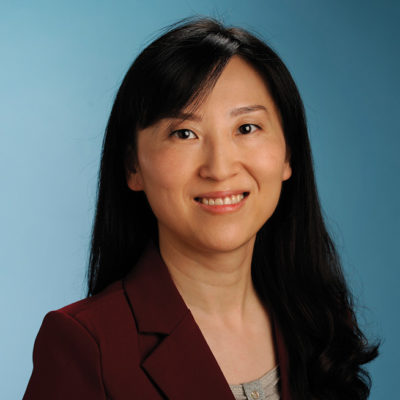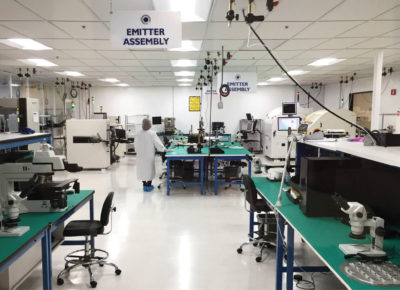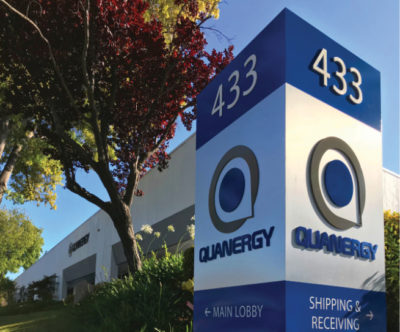
Quanergy’s headquarters in Sunnyvale, California. The company doubled its footprint in this building during 2019.
Readers of LIDAR Magazine know that suppliers of lidar sensors who cater primarily to automotive customers have been making a big difference to the geospatial world, since their products are often well suited to UAV-lidar as well as MMS applications. Managing editor Stewart Walker traveled to Quanergy Systems, in Sunnyvale, California—the heart of Silicon Valley—to explore the situation in more depth. Hosted by marketing communications manager Sona Kim, he was able to talk at length to co-founder and CTO Dr. Tianyue Yu (first name pronounced T-N-U-A). Yu mentioned the partnership Quanergy had begun in 2019 with GeoCue1, related to the use of the Quanergy M8 sensor in the GeoCue TrueView 410 product. She knew the UAV-lidar integrators well, including LiDAR USA, another customer with which Quanergy had announced a partnership2. Indeed, LiDAR USA had been on the Quanergy booth at the recent CES event in Las Vegas. She was familiar too with Geodetics and YellowScan. Quanergy is grateful for the inputs of the UAV-lidar integrators, which have led to product improvements. She was well aware of the strong competition on the sensor side amongst the automotive lidar suppliers, not only in mapping but also in security applications. Quanergy’s relatively low price point is a factor in the adoption of UAV-lidar, since the lidar sensor is no longer the most expensive component of the integrated system, nor of systems that can easily be transferred between UAVs and land vehicles. Yu hoped the smart cities trend will be a driver of significant growth in the UAV-lidar market. “Lidar is the best 3D device,” she exclaimed, foreseeing partnerships with players in the smart city/digital twin space, “now that we are getting more and more mature … there are a lot of synergies there.” She was conscious of their distribution channels and their capabilities in the area of 3D rendering, to which lidar could contribute so much. Mounting lidar sensors on construction equipment becomes more realistic as prices fall and the demands of the automotive market ensure reliability. UAV-lidar integrators tend to test every single system before shipping, so reliability is essential—shortcomings will be discovered! We discussed the difference between the requirements of the automotive market—to detect objects in a vehicle’s path—and mapping. Yu emphasized that Quanergy’s precision is 3 cm: the company does not aspire to millimeters at present, because its main markets don’t need this. We turned to questions submitted in advance.
Editor’s note: A PDF of this article as it appeared in the magazine is available HERE.
LM: Please tell us a little about yourself. Born in China, you earned a bachelor’s degree there and proceeded to a PhD at Cornell, after which you occupied a series of high-level, high-tech positions before founding Quanergy in 2012. What guided your career choices during this period and how did it result in your entry into and subsequent staggering effect on the lidar world? How did you meet Dr. Eldada [Louay Eldada, co-founder and former CEO of Quanergy] and decide to work together? Do you perceive yourself as a technical genius, holder of multiple patents, or as a business genius, with a string of successful start-ups and divestitures, or both?
TY: The history part! After graduating from Cornell, my focus was in nanotechnology, electronic materials and high-resolution imaging lasers. My PhD was about two-photon lithography. I was very much into lasers. I came to Silicon Valley because my husband was working here. I worked for a number of companies, in nanotechnology and high-resolution imaging, all laser-based. Louay and I worked together in another company, then we left and formed Quanergy. We followed a very structured process—when you form something new, you want to do something impactful to society, right? We do not do it out of convenience, it’s more about an end in mind, then we come back to what we could do. Healthcare, population, energy, transportation impact a society. In the end, we narrow down, see what we can do, we can’t build a Facebook. Even in 2012, the general public didn’t know about autonomous driving, yet it had been in DARPA Challenges as early as 2005. SICK and Velodyne LiDAR really benefited from those. When we founded, there was a need to dramatically lower the cost. The overall vision is that lidar is the best centimeter-accuracy 3D device to acquire this information. Cameras, radar, these compress the 3D world into 2D presentation, but lidar opens up a new dimension of context—everything’s about context—so lidar is an important piece of autonomous driving, but at the same time has uses in many other industries, but has not been fully explored yet because it was too expensive in the past. Automotive is only one of the industries we serve—that’s a differentiator. Our vision has always been to map the world in 3D. Autonomous driving is one application of that—high resolution, distance measurement, object detection, collision avoidance etc. But our vision from day one has not just been automotive, though sometimes people paint us with that brush. We set out to revolutionize society with the third dimension. This explains interaction with Autodesk, Trimble etc., which are not automotive companies, and our wish to have mapping, smart city and security products too. We just go with the flow when people see us that way [automotive], but in conversation it’s easier to explain how the platform can revolutionize many industries.
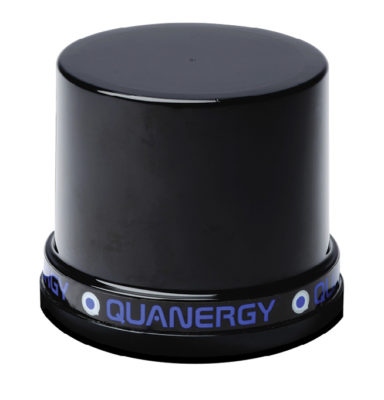
Quanergy M8, the firm’s sensor best known in the geospatial world. The “M” originally stood for “mechanical”. Quanergy emphasizes the product’s low cost alongside high performance in terms of range, horizontal resolution and accuracy. Critical technical specifications include: 8 detection layers; 905 nm; range 0.5-100 m @ 80% reflectivity (M8-Ultra 200 m); range accuracy 3 cm (1σ @ 50 m); frame rate 5-30 Hz; angular resolution 0.033-0.132° depending on frame rate; FOV 360° horizontal, 20° vertical; output rate 432,000 points per second, 1 return/1.3 m, 3 returns; 900 g; 103 mm diameter, 87 mm height. The M8 is available in four models: M8 core, M8-Plus, M8-Ultra and M8-PoE+.
LM: We didn’t realize that. For the mapping world, the significance is that you have access to R&D funds from car companies, so you can produce developments and units at a lower cost that become available for mapping, which is the beneficiary. But you see it differently—you saw in 2012 that you could make a really good lidar sensor that would revolutionize many industries. That was how you got in. You obviously have enormous technical skills, but do you or Dr. Eldada see yourself as a business genius, or a technical genius, or both? That’s what Silicon Valley’s all about!
TY: You have to cover for both, you can’t be only on the left bench. But not just a talking point—serious technical substance, so you are credible and have judgement. You have to have both to be good for the company and help the drive forward.
LM: There were incredibly able people at GeoBuiz, but they all have to get venture capital. I’ve heard Dr. Eldada speak and he’s very good. He’s compelling. Without that gift, you’re not going to get the money.
TY: Yes, indeed. He and I went out together to the venture capitalists. Depending on the audience and the setting, sometimes I talked more, sometimes he did. I’m bilingual and he speaks Arabic and French—he’s from Lebanon—so that helps. He’s the CEO, often he talks more, he’s the public face of the company, but I go to customer meetings and pitch there. That’s a really critical capability, representing the company in that way. And sometimes they don’t get to hear what they want. Those are the customers I like the most—they challenge you and they are not easy to fool! So it’s extremely important to have both a business and a technical sense.
LM: When you look at a start-up’s website, you see the glittering talent of the whole team! I’ve read through the details of Quanergy’s leadership team. They are incredibly experienced and talented. I’ve noticed this characteristic in many start-ups, not just in lidar but also in space. How does it work? How do you plan your leadership team and find it? What’s the key to success?

Quanergy S3 solid-state lidar sensor. Quanergy promotes S3 as a high performance, automotive-grade, smart sensing solution that is ideal for a wide variety of applications in transportation, industrial automation, security data analytics, and mapping. The economical price point enables high-volume deployment of lidar. Two models are available: S3-8 for automotive and S3-2 for non-automotive, industrial applications.
TY: Good question. Maybe I can answer that in reverse order. CFO Patrick Archambault became director of finance in 2016, but CFO in August 2019, a new position. He plays an important role managing the finance team. Gary Saunders joined in April 2019 as chief revenue officer, instrumental with the sales team. Enzo Signore, CMO, joined in July 2019, playing a critical role in product-market fit. Engineers can make anything, so you want to make sure you make something with the needs and the business potential behind it. These are the relatively new additions. Raj Bhullar, VP of manufacturing, joined in 2014, early on, in response to need to ramp up production. Early hires were entrepreneurially able, since they were joining a company of less than20 people. I myself was soldering, making parts etc. at that time! Why did they join? A lot of the people joined following our vision of revolutionizing the world in the third dimension. It’s about photon to insight, not just mapping but the whole 3D mapping world. From lidar, you get distance and 3D information, then smart sensing solutions, enabling ubiquitous deployment worldwide. Lidar is a doorway for people-counting. That is the insight, we’re not just building lidar in our team. Insights come first, then we make an impact on society. For mapping, you use a high-quality sensor. IT will be deployed in airports, e.g. to measure queues. A lot of our team members joined based on the alignment to the vision—they also believe—radar is 1D, cameras 2D, lidar 3D. The seeds grow in the different areas—3D printing and AR are 3D. If you connect the dots, these are rising above the water. Lidar is the best device to tie them together. In 2014, Google built the Tango and provided it in response to proposals, i.e. investment from Google for free. They wanted to foster a community to develop 3D software, acknowledged to be tough without big investments. Meanwhile, Apple acquired 3D-sensor maker PrimeSense in 2013 and Microsoft developed Kinect as early as 2010, having acquired 3DV Systems and Canesta en route. Amazon’s Fire Phone, launched in 2014, was a failure, but it had a strong 3D emphasis, so is part of the same trend—the big players value 3D, so lidar matters. Everyone values it—except Elon Musk!
LM: The CEO of Velodyne LiDAR has just moved upstairs as chairman and replaced himself with an internal promotion. The same has happened in Trimble. That’s not going to happen here yet? Will you be promoted? Any comments?
TY: By Series-C time, 90% of CEOs are no longer there—that’s a fact in the venture investment community. Entrepreneurs want new things—it’s very natural for them to move from company to company. You will hear some news from us too! I was not surprised by your question.

QORTEX™ is the perception software that Quanergy supplies with its lidar sensors. The QORTEX variants provide a flow management platform, resulting in a product family that currently comprises three solutions: QORTEX DTC (paired with M8), used for security and smart city; QORTEX People Counter (paired with S3-2) for smart space and smart city; QORTEX Access Control (paired with S3-2) for security and smart space.
LM: I’ve written a couple of articles about Cepton and I’ve noticed that folk here in Silicon Valley seem to jump between competing companies. Is that a good thing, i.e. is it stimulating for both the recruiters and the recruited, or is it too dangerous in terms of compromise of IP?
TY: Many of our team members went to Cepton and initially we were not happy. But, looking at the big picture, there is no “no compete” in California. Employees are free, though they must preserve confidentiality. I think it’s good for the health of Silicon Valley—cross-pollination. You have measures of protection such as patents and copyright. Ultimately, in competition, you have to cross-pollinate yourself!
LM: I realize that you probably don’t want, as a privately owned company, to say much about performance data, but is there anything you are able to tell me about capital raised, revenues, profitability, growth, number of employees, split of revenues amongst your different business areas (transportation, mapping, industrial automation, security), percentage of revenue invested in R&D, etc., to give readers some detail about your company?
TY: Yes, we’re still privately held, on VC. We employ around 100 people. Revenue has grown annually and from half year to half year and we expect further growth in 2020.
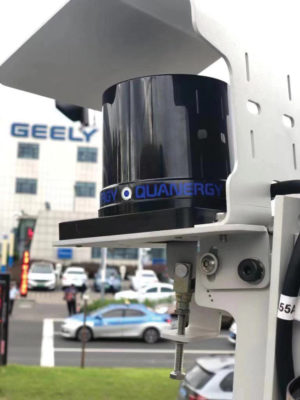
Quanergy has been working on a joint development project with Zhejiang Geely Holding Group Co., Ltd, which is a Chinese automotive company commonly known as Geely. The project is located near Geely’s headquarters in Hangzhou, Zhejiang province, China.
LM: I’m from the geospatial world, so first of all I want to thank you for your wholehearted participation in this market, which must be tiny compared to your primary automotive vertical. Why are you active in the geospatial, i.e. UAV market? What’s in it for you? I note that the UAV-lidar integrators are embracing your product. These are important testimonials in the UAV/geospatial world, so congratulations are in order. Do you know if anyone is using the M8 in a mobile mapping system, or even a tripod-mounted terrestrial lidar system?
TY: Yes, we have a number of customers with our sensors in MMSs. In China and Australia, they map powerlines.
LM: Please explain, in a simple way since I don’t have degrees in either physics or electronics, how your technology differs from that of your competitors. Do you see your USPs in terms of price levels rather than technology or performance? You claim to be disruptive on price—please say more! I think that the high quality and reliability of the M8 have been publicized too.
TY: I can’t say too much about how it’s made. The differentiators are point density and lower price-point. Quanergy offers the best value in terms of $ per point, with only eight beams, compared to Velodyne’s 16, but we are faster, with 432,000 points per second, compared to ~320K from Velodyne, so we are 40% higher. We do this through a very high firing rate of the laser, which facilitates a very high horizontal angular resolution of 0.03° compared to competitors’ 0.1°. This is very helpful to engage customers. It’s good for power lines, where it really makes a difference. Also, in order to have high data rates, we use optical fiber systems and inductance power transfer for reliability of construction and high efficiency. The current mapping product is not yet based on solid-state technology, but the second-generation product will be. Our security product is solid-state.
LM: So you use solid state technology, rather than micromotors? And you do something with the phase of the beam?
TY: Our first product like that is for entryway security—its productization has priority. It does not have a 360° FOV like the mapping product. 360° FOV is not necessary for flying, but is important for MMS. It’s a spinning device, not a prism but a rotation mechanism inside the unit, which is a mechanical part. The mapping industry has been enjoying the introduction of our lidar and not been so picky. In flying they have moving parts, so they live with it! Also, flight times are typically below 30 minutes, so the market does not yet demand solid state. There are different means to the end. We do indeed have a solid state solution, based on optical phased array technology. It’s coming from interference patterns—think of throwing two rocks in the water and looking at the patterns. Think of thousands of rocks, and total control over where you throw them. You control the phases, so can control the outgoing beam and can steer it by controlling the phase. It’s all electronic, with no moving parts. Radar is also based on the phased array but at a different wavelength from our 905 nm.
LM: Good price-point, high reliability, customer satisfaction. No-one will complain about that approach!
TY: We want to focus on the product speaking for itself and customers speaking for the product. We invited customer vendors to our booth at CES.
LM: Have you had any thoughts on going public?
TY: No thought of going public. We focus on execution. M&A is another possible question, they are all symptoms of success. You must stand on your own feet and become successful.
LM: There must come a point when you don’t need VC any more. You can use revenue and profit.
TY: We are still in the growing phase, so we need funding. We are not profitable or saving money for dividends, so we need VC injection. Going public is one way to get funding, but in the Valley there are huge private companies. The board will decide what is best.
LM: Clearly, you have to offer low-level software or APIs so that your customers can enjoy your sensors, but with the QORTEX you seem to be offering quite extensive software. Is that right?
TY: We do offer an SDK with M8 so end-users can use output to build their own software. Customers are at different levels, e.g. Jeff Fagerman doesn’t use our SDK but builds his own. Some other customers use our SDK to feed into their own systems. Other customers want object information rather than raw data, so they use our software.
LM: How did CES 2020 go? Do you enjoy trade shows? During the show, you announced the partnership with Geely—please tell us more about that?
TY: Yes, it was a good show. We have been there for six years now, demonstrating a different aspect each year and this year we invited customers to co-exhibit. Remember our focus is not just automotive but wider. We set out to be in other markets. The Geely relationship is very exciting. The project is more on the smart city front. In Geely’s HQ, there are intersections with M8s mounted. It’s a pilot project. Currently smart city projects are government-driven, but Geely’s is private and the pilot went very well. We collect intersection information, both pedestrian and vehicles, and send it to the vehicle to make things safer: infrastructure-car communication, which is also tied to 5G. We also had a project in Adelaide, Australia3.
LM: What is your relationship with Jaguar? I ask that because they make nice cars and they’re British, albeit with Indian ownership!
TY: We had a press release in 2017. We have similar partnerships with many car companies. You can’t buy a Jaguar car with our lidar yet!
LM: Your big, exciting market is autonomous vehicles. It may be some time before these are universally permitted and commonplace, but is the ADAS market attractive to you in the meantime?
TY: ADAS and AV are two parallel tracks in the AV market. The whole thing is about reducing cost.
LM: I see two other competitors who could be interesting. Livox, which is related to the AV supplier DJI, seems to have some new technology. Intel, which has been active with its ADAS/AV Mobileye acquisition for some years, recently launched the RealSense L515 at under $500. Do you have any thoughts on these entrants?
TY: Intel has been active for a number of years, e.g. for the stereo camera. Again, it supports the notion of 3D. It has range limitations and is prone to lighting changes. It performs well in warehouses and indoors. Our take is, “The more players, the better”. It’s better, if you’re confident in yourself, your competitiveness, to have more people scratching the surface together and then you discover more applications. We need to out-innovate ourselves and then we can stay in the leadership position. Livox’s cheap model is $800. They are located in a manufacturing hub of China and they are part of DJI, so have a ready outlet. They have different versions of the product. You can’t make a product that suits everything.
LM: Intel’s MobilEye was an acquisition.
TY: Yes, in 2017, in addition to RealSense stereo cameras. They are focusing on the ADAS market. MobilEye began around 1999. After first 10 years, it’s hard, you have to build the foundation. They are keeping a big base in Israel.
LM: What does the future hold for Quanergy, especially in the geospatial market?
TY: We are growing in many different markets, in accordance with our vision. We address markets in parallel with AVs, which is also in the R&D stage. We support AV customers as a supplier, but in other markets we are a big player: in security and IoT, we focus on products to stay in a leadership position. The second player climbs across your body. Multiple markets are an advantage. The geospatial market is an emphasis this year. We have a successful M8 but we want to keep our leadership position. We had a meeting yesterday with our business team about updates. We don’t want to stay in the same place—product cycles are fast and people catch up. We listen to the customers, value their inputs and do what we need to do to fill gaps.
LM: Dr. Yu, thank you very much indeed for your time and frank answers.
A look round
Yu and Bhunnar took me on a quick factory tour. Quanergy had doubled its space, within the same building, in 2019. The heavily used facility, packed with cubes, benches, tools, electronic components and finished or partially finished lidar sensors, was not so different from scenes at Applanix and Cepton Technologies that LIDAR Magazine had witnessed during research for other articles. Quanergy used to have production in the Sunnyvale headquarters, but, as demand has increased, is outsourcing it, to companies that can ramp up very fast for mass production. They do pre-production and develop software in Sunnyvale. Bhullar showed the main components of the M8 and how they are assembled. Various sub-assemblies, such as the rotating mechanism, are tuned for maximum performance, e.g. alignment, range and smoothness. Getting the best range is vital in competition. Then there is balancing, integration and testing—calibration, burn-in, range test, accuracy test etc. Yu said they also use third-party test facilities for procedures they can’t do in-house. “Our quality is the best in the world in the lidar industry at this time,” said Bhullar. Yu agreed! “We’re very proud of our industry awards and we’re confident of our processes”4. The company’s manufacturing processes are ISO 9001:2015 compliant. We looked at the solid-state lidar for people-counting. Yu was in her element, showing me the components and trying to explain to me how it all works. There are variants of the technology platform, so there are ways to be agile to meet future demands. Yu is involved in the design, but then comes the fabrication. The chip fabrication is done in Silicon Valley: this service is easy to find locally as three quarters of the world’s expertise is within 20 miles. We walked through the garage area, where there were two AVs under development, donated by Mercedes, an endorsement of which Dr. Yu was clearly proud. They also collaborate with Toyota and other car companies. She showed me the water-resistant parts. Rather than IP67, they have IP69K, which is appropriate for fitting on garbage trucks that are power-washed every day. Yu also stressed every unit’s two-year warranty.
Back in the conference room, we discussed how crowded the mapping market-space is, but I admitted it is still hard to judge the size of the UAV-lidar market. Quanergy knows the UAV-lidar integrators, but wants more market share. The company is agile, active and hungry. I was impressed with their keenness to understand the geospatial lidar market and the players.
Endnote
I left Sunnyvale with much to ponder. Silicon Valley is different. The technological and intellectual excellence, energy and drive of the players are palpable and rub off on visitors. Quanergy and its competitors will continue their intense activity in the automotive and other markets. The geospatial world, therefore, will be a big beneficiary as performance and quality rise, prices fall, the integrators prosper and the end-users relish the ROI.
Postcript
This interview took place on 15 January 2020. On the following day, Quanergy revealed that Dr. Eldada had stepped aside as CEO and would continue in a “consultant and evangelist role”5. Indeed, he had left the board of directors on 13 January, with Dr. Kevin Kennedy taking over as interim CEO. Dr. Kennedy had joined Quanergy’s board in April 2019 and became chair in October. Clearly, Dr. Yu could not reveal this news to me, since the interview took place before the embargo date.
3 https://www.youtube.com/watch?
v=i7FXlgBO9o0; https://www.computerworld.com/article/3471433/adelaide-pilots-smart-city-technology.html. The Quanergy components were M8s and Qortex DTC (detection, tracking and classification) software.
4 Quanergy has won multiple awards including: Consumer Electronic Show’s (CES) 2017 Best of Innovation Award in the vehicle intelligence category for its S3 solid-state lidar sensor; 2017 ASTORS Homeland Security Award for Best Perimeter Protection System; Best Consumer Product in Automotive and Telematics from Juniper Research in its annual Future Digital Awards for Technology and Innovation in 2018; 2018 Silicon Valley Chamber of Commerce’s 2018 Murphy award for Outstanding Innovation in LiDAR Sensing Technology; and 2019 Best of Sunnyvale Award in the Manufacturers category.
5 https://www.bloomberg.com/news/articles/2020-01-16/quanergy-ceo-steps-down-after-driverless-tech-unicorn-stumbles. Interestingly, the title of this article includes the word “unicorn”. Yu would not be drawn during our interview by my question whether Quanergy was a unicorn.
